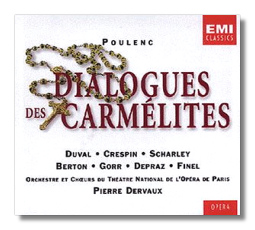|
| This is my Once or Twice a Fortnight post from 14 November, 2013. |
November is the “Month of the Dead” and also an opportunity to highlight the 50th anniversary of Francis Poulenc’s passing. This convergence made me program his opera Dialogues of the Carmelites for my OTF Opera of the month – and I plan to program my Poulenc homage podcast around the end of the month.
Inspired by a novella by Gertrud von Le Fort (Die letzte am Schafott, in English - The Last to the scaffold), the opera was created January 26, 1957 at La Scala in Milan in an Italian version of Flavio Testi. The first performance of the French version took place at the Paris Opera on 21 June of the same year.
The opera explores the drama surrounding the Carmelites of Compiegne, sixteen Carmelite nuns (cloistered) sentenced to death in July 1794 by the Revolutionary Tribunal on the grounds of "fanaticism and sedition." Arrested and convicted at the height of the Terror, they had two years earlier, vowed to give their lives to "appease the wrath of God and the divine peace that his dear Son came to bring the world." Their peaceful death on the scaffold impressed the crowd and was one of the many seminal events that put an end to this dark chapter in post-Revolutionary France.
The central protagonist (fictitious) is Blanche de la Force. She joined the Carmel of Compiègne in hopes of protecting herself in the cocoon of a convent. But fear continues to haunt her and her obsession with death is amplified by the terrible and miserable agony of the Prioress: for this model of faith undewent much suffering.
Summer 1794: The Great Terror. The Carmelites were arrested, imprisoned, judged. Previously, the king, the queen, Danton, Camille Desmoulins, and thousands more were guillotined, the Marquis de la Force also (father of Blanche). It is in his deserted mansion that Blanche, who managed to flee, finds refuge. But on July 17, she joined her sisters singing the Salve regina as one by one they are guillotined. The last voice you hear will be hers ...
Dialogues des Carmelites generally is considered a drama of faith persecuted at the time of the French Revolution. For some, the purpose goes further and introduces a sense of abandonment, if not revolt for these neglected sisters face death.
Composer and author (as they opera simply is a musical staging of the play) lead us to the heart of a drama of isolation where certainties bask, where the death of the First Prioress is not religiously correct. The wanton violence of the outside world has torn the compromise that justified their social isolation. What good is there in the world when there are no more people to save?
The Performance

The performance of the opera I have retained features the original Paris cast under conductor Pierre Dervaux. There are probably more modern performances, but it was long the benchmark for this opera. The performance also features the introduction of commentator Sean Bianco.
Francis POULENC (1899-1963).
Dialogues des Carmélites , FP 159
Opera in three acts and twelve scenes., French libretto based on the play by Georges Bernanos (with autoristation Emmet Lavery), according to a novella by Gertrud von Le Fort and scenario by Raymond Leopold Bruckberger and Philippe Agostini
PRINCIPLAL CAST
Denise Duval (Blanche de la Force)
Régine Crespin (Mrs. Lidoine, the new prioress)
Liliane Berton (Sister Constance)
Rita Gorr (Mother Mary)
Choir and Orchestra of the National Opera House of Paris
Pierre Delvaux, conducting
Librettto: http://livretpartition.com/livretopera/poulenc/1.pdf
Synopsis: http://www.metoperafamily.org/metope...px?customid=38
Hyperlink (Internet Archive): https://archive.org/details/04Act2_201310.

No comments:
Post a Comment